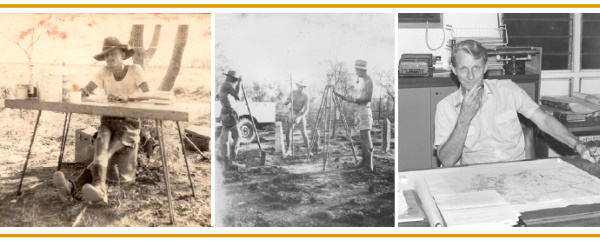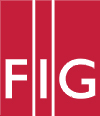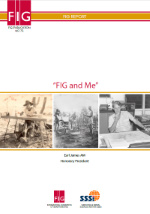FIG PUBLICATION NO. 75
FIG and Me
My Twenty Five Years in the International Surveying Arena -
Earl James
FIG REPORT
Author:
Earl James, FIG Honorary President

FOREWORD
As the President of FIG, I am privileged to announce the release of the
publication “FIG and Me – My Twenty Five Years in the International
Surveying Arena” written by Earl James, FIG Honorary President. This book
provides an insight into Earl’s international surveying accomplishments, and
a unique perspective of the FIG workings, achievements, and challenges
experienced by our establishment, during the period 1988 – 1996. Back then
FIG Council and Office was known as the “Bureau”, and from 1988 Earl served
as a Vice President with the Finnish Bureau for four years, and then as FIG
President of the Australian Bureau, who hosted the XX International Survey
Congress held in Melbourne in 1994.
For those who do not know, Earl is an Australian icon of surveying, and
is recognised and respected as a survey pioneer of the Northern Territory of
Australia. For 44 years Earl worked as a professional surveyor, starting as
an “outback” cadet surveyor with the Lands and Survey Department,
progressing to a Senior Licensed Surveyor in government, and then
establishing a reputable and successful private business in the Northern
Territory. Earl in the course of his professional career surveyed numerous
property land boundaries in pastoral, rural, and urban environs, he mentored
many surveyors or land related professionals, and contributed to the growth
of the Northern Territory through his expertise as a Planner and the
Chairing of numerous land development Boards. Both the surveying and
planning profession have honoured Earl with the accolade of “Honorary
Fellowship”, and the Australian Government have recognised his service to
industry by appointing Earl as a Member of the Order of Australia.
Many of those who know Earl, always recount his eloquent speeches, his
strategic thinking, and plans for FIG, which when combined help shape the
foundations of the organisation that we know today. It is therefore a great
pleasure and honour for me to write this foreword and for FIG to be part of
this publication. I sincerely hope that FIG members enjoy reading this
personal record from a Northern Territory of Australia outback surveyor who
visited over 50 countries whilst leading the way.
In the name of the International Federation of Surveyors I thank Earl for
his outstanding engagement for our profession, for his activities in the
name of FIG, and also for his wonderful memories.
Rudolf Staiger
President (2019–2022)
Preface
Surveying is a pastime enjoyed (or endured) by many, many people who
carry out a host of different occupations; occupations that could range from
the simple task of polling people with a question of political significance
to the complicated and highly skilled task of measuring the shape and size
of the earth.
In some countries the term ‘surveyor’ is used to refer to those who carry
out surveys such as those required to define property boundaries or the
surveys needed to control the construction of bridges, roads, multi-storied
buildings and other structures but in other countries the term is also used
to cover those who simply collect information and use it to come to a
specific conclusion such as the determination of the value of a property, or
how best to design a new suburb, or the production of a particular map.
Surveyors have been around for a long time. Evidence of this can be seen in
such ancient works as the three thousand year old map recently found
stencilled into the rocks of Italy’s mountains. Ancient art depicts
surveyors using crude tapes and other measuring implements while the
rectilinear layout of most excavated lost cities is enough to convince even
the casual observer that surveying is a very ancient art. Indeed, surveying
is often referred to as the world’s first, or oldest profession though this
is hotly contested by the military. Even so, military ranks always have
contained surveyors though they were referred to as engineers. Roman
military surveyors two thousand years ago were famous for their long
straight roads and the symmetry of their military encampments.
The International Federation of Surveyors defines a surveyor as, among
other things, ‘a professional person with the academic qualifications and
technical expertise to practise the science of measurement’. I am a
surveyor. I have worked both as a government employed surveyor and as a
private practicing surveyor for the best part of forty six years in the
Northern Territory of Australia. During that time I took a great interest in
the politics of the profession to the extent that over the years I
progressed from being an
associate member of the Institution of Surveyors Australia (ISA), to
national President of that Institution thence to Vice President of the
International Federation of Surveyors (FIG), then to President of that
federation and finally to President of the International Union for Surveys
and Mapping (IUSM). This is the story of my involvement with the Féderation
Internationale des Géomètres (FIG).
NOTE: For list of acronyms see Glossary.
Introduction
18 July 1878 – 1st Congress and Founding of Féderation Internationale
des Géomètres (FIG) in Paris (France)
On 18 July 1878 a select band of representatives from the professional
surveying associations of seven European countries met in Paris, France at
the instigation of the associations from France and Belgium. The objective
of the meeting was to find a mechanism by which those associations could
exchange information about the profession and changes in work practice as
well as news about developments in research and exploits of individual
surveyors. The end result of the meeting was the formation of the Fédération
Internationale des Géomètres otherwise known as Internationale Vereinigung
Der Vermessungsingenieure or the International Federation of Surveyors. The
Federation was founded as a non-governmental organisation and its purpose
was described as being ‘to support international collaboration for the
purpose of surveying in all fields and applications’.
The member countries of this fledgling organisation were France, Germany,
Great Britain, Belgium, Italy, Spain and Switzerland. As the people in the
majority of those countries spoke either French, German or English the
meeting agreed that all three of those languages should be official
languages of the Federation and that the shortened version of the name
should be FIG, the initials of the French version of the name. The
organisation has been known by all and sundry as FIG until the present day
and no doubt will continue to be so known. The decision to have three
official languages required all documents to be recorded in three versions
and for conferences to have simultaneous translation facilities. This was
not overturned until 1995.
The newly created federation was formed with four principal units: a
General Assembly of member associations; a Permanent Committee; a number of
Technical & Scientific Commissions and an executive committee known as the
Bureau. This structure remained in place until 1998. The definition of a
surveyor was fairly simple but was stated to include appraisers and valuers.
This definition was too simple for most people and was to remain a bone of
contention until a new all-inclusive definition was agreed to in 1991.
This meeting in 1878 was taken to be the 1st Congress of FIG. The next
congress was held in Brussels in 1910 and the 3rd Congress was held once
again in Paris in 1926 having been disrupted by World War One and the
tumultuous events in Europe after that event. Thereafter some regularity
appeared with congresses taking place every three or four years except
during the years of World War II. Membership grew apace but all member
associations came from European countries until the United States became a
member country in 1935. The first congress to be held outside Europe was
held in Washington, USA in 1974 and the first to be held in any country
other than one in Europe or the USA was held in 1994 in Melbourne,
Australia.
The Institution of Surveyors, Australia (ISA) first sent a delegation of
observers to an FIG Congress in 1962 when the 10th Congress was being held
in Vienna, Austria after which the Council of the Institution considered the
possibility of becoming a member of the Federation. The matter was put to
the general membership who agreed to the idea and in 1965 the Council of ISA
lodged a formal application for membership which was considered by the
General Assembly of FIG at the 11th Congress held in Rome that year. The
application was successful. The Institution of Surveyors, Australia thus
became the first Australian association to become a member of FIG. The
Australian Institute of Valuers became a member in 1970 but resigned from
the Federation in 1983.
ISA continued to be a member of FIG and had a significant impact on that
organisation. Administration of the Federation was in the hands of the
Australian Institution during the four year period 1992 to 1995 during which
time Bureau members were successful in achieving great changes to the
structure of the organisation and to policy matters. I became involved in
1971 and went on to become the President of the Federation for the period of
the Australian administration.
Read the full FIG Publication 75 in pdf
Book 1: 1972 to 1992
Book 2: 1992 to 1995
Book 3: Epilogue - 1996 to 2010
Copyright © The International Federation of Surveyors (FIG),
May 2020.
All rights reserved.
International Federation of Surveyors (FIG)
Kalvebod Brygge 31–33
DK-1780 Copenhagen V
DENMARK
Tel. + 45 38 86 10 81
E-mail: FIG@FIG.net
www.fig.net
Published in English
Copenhagen, Denmark
ISSN 1018-6530 (printed)
ISSN 2311-8423 (pdf)
ISBN 978-87-92853-94-3 (print)
ISBN 978-87-92853-95-0 (pdf)
Published by
International Federation of Surveyors (FIG)
Layout: Lagarto
|

























